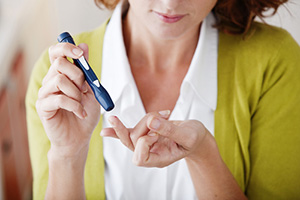 Diabetes is usually put into two categories:
Diabetes is usually put into two categories:
In type 1 diabetes, your body attacks and destroys your pancreatic cells that produce insulin. If you have no insulin, your blood sugar level spikes. This condition most often starts in early youth.
In type 2 diabetes, your body has become resistant to insulin and cannot use it properly. This leads to high blood sugar levels.
Type 2 diabetes usually begins developing in people after 40. And before it’s called full-blown diabetes, doctors warn you about pre-diabetes.
But new info warns that your pre-diabetes may actually be a misdiagnosis of Type 1 Diabetes, even if you’re older.
This disease needs to be urgently treated in a very different way than Type 2.
When type 1 diabetes occurs in adults, it is called latent autoimmune diabetes in adults (or LATA, in short).
As in the case of children, your immune system mistakenly identifies your insulin-producing cells as a threat and destroys them.
But, because it starts later in life and often progresses more gradually than type 1 diabetes in children, it seems to resemble type 2 diabetes and can be mistaken for it.
As a result of these similarities, a 2010 study in Diabetes Care has estimated that up to 10 percent of people diagnosed with type 2 diabetes actually have type 1.
If doctors are unsure, they can test the patient’s blood for diabetes-related autoantibodies. The more of these types of autoantibodies in your blood, the more likely that you have or will develop type 1 diabetes.
This is a sure way to distinguish between the two.
But why is it so important that the conditions be separated and diagnosed correctly?
While type 1 diabetics can help keep their blood sugar low by eating low carbohydrate diets, they must receive insulin, usually taken through injections.
Without these injections, they will die, as their bodies have no insulin and no other way to control blood sugar. Therefore, misdiagnosing type 1 as type 2 can be deadly.
Type 2 diabetics, on the other hand, can remedy their condition through lifestyle changes like exercise and dieting.

 Overcoming IBD
Overcoming IBD Multiple Sclerosis
Multiple Sclerosis Banishing Bronchitis
Banishing Bronchitis Gum Disease Gone
Gum Disease Gone Overcoming Onychomycosis
Overcoming Onychomycosis Neuropathy No More
Neuropathy No More The Prostate Protocol
The Prostate Protocol Brain Booster
Brain Booster
 Ironbound
Ironbound
 Solution for Shingles
Solution for Shingles
 The Bone Density Solution
The Bone Density Solution
 The Ultimate Healing Protocol
The Ultimate Healing Protocol
 The Parkinson's Protocol
The Parkinson's Protocol
 The Chronic Kidney Disease Solution
The Chronic Kidney Disease Solution
 Overthrowing Anxiety
Overthrowing Anxiety The Fatty Liver Solution
The Fatty Liver Solution The Hypothyroidism Solution
The Hypothyroidism Solution
 The End of Gout
The End of Gout The Blood Pressure Program
The Blood Pressure Program
 The Oxigized Cholesterol Strategy
The Oxigized Cholesterol Strategy
 Stop Snoring And Sleep Apnea Program
Stop Snoring And Sleep Apnea Program
 The Arthritis Strategy
The Arthritis Strategy The Vertigo & Dizziness Program
The Vertigo & Dizziness Program The 3-Step Diabetes Strategy
The 3-Step Diabetes Strategy Hemorrhoids Healing Protocol
Hemorrhoids Healing Protocol The Erectile Dysfunction Master
The Erectile Dysfunction Master Weight Loss Breeze
Weight Loss Breeze The IBS Program
The IBS Program The Insomnia Program
The Insomnia Program The Migraine and Headache Program
The Migraine and Headache Program The Neck Pain Solution
The Neck Pain Solution The Menopause Solution
The Menopause Solution The Ejaculation Master
The Ejaculation Master The TMJ Solution
The TMJ Solution The Acid Reflux Solution
The Acid Reflux Solution The Fibromyalgia Solution
The Fibromyalgia Solution The Psoriasis Strategy
The Psoriasis Strategy